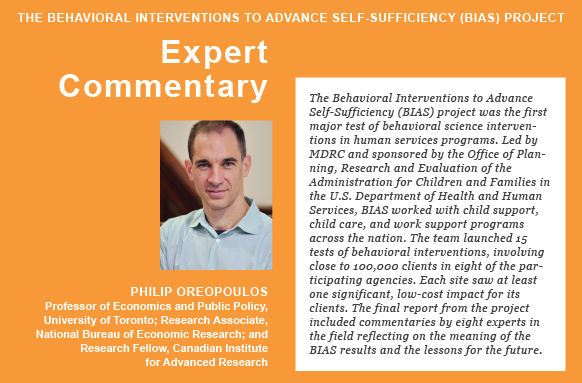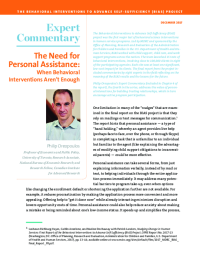The Need for Personal Assistance
When Behavioral Interventions Aren’t Enough


Philip Oreopoulos’s Expert Commentary (included in Chapter 4 of the BIAS final report), the fourth in the series, addresses the value of personal interactions for building trusting relationships, which in turn encourage active program participation.
One limitation in many of the “nudges” that are examined in the final report on the BIAS project is that they rely on mailings or text messages for communication.[1] The report hints that personal assistance — a type of “hand holding,” whereby an agent provides live help (perhaps face to face, over the phone, or through Skype) in completing a task that is unfamiliar to an individual but familiar to the agent (like explaining the advantages of modifying child support obligations to incarcerated parents) — could be more effective.
Personal assistance can take several forms, from just explaining information verbally, instead of by mail or text, to helping individuals through the entire application process immediately. It may address many potential barriers to program take-up, even when options like changing the enrollment default or shortening the application further are not available. For example, it reduces procrastination by making the application process more convenient and more appealing. Offering help to “get it done now” while already interacting minimizes disruption and lowers opportunity costs of time. Personal assistance could also help reduce anxiety about making a mistake or being reminded about one’s low-income status. It speeds up and simplifies the process, avoiding the need for detailed instructions and review. It may even eliminate the need to look at a form or an application at all. Offering assistance increases a form’s visibility and may improve perceptions about the value in filling out the form. The personal encouragement may also empower individuals to consider more the possibility of change. Most important, a personal interaction has the potential to increase trust in reacting to encouragement to do something unfamiliar. Analogous to responding to a doctor’s or an accountant’s advice, we are more likely to take action when we trust the person who is offering that advice.
The BIAS study results from Indiana and Oklahoma,[2] in addition to an H&R Block FAFSA experiment,[3] suggest that behavioral interventions that are designed to increase active participation in benefit programs may be more successful if they can incorporate more personal interactions with targeted individuals. The interventions may be more costly, but may make up for that added cost in being more effective. Springing on the opportunity to complete a form “now” or being able to respond to individuals’ questions, and creating more trust in trying something new, may make an important difference.
[1]Lashawn Richburg-Hayes, Caitlin Anzelone, and Nadine Dechausay with Patrick Landers, Nudging Change in Human Services: Final Report of the Behavioral Interventions to Advance Self-Sufficiency (BIAS) Project, OPRE Report No. 2017-23 (Washington, DC: Office of Planning, Research and Evaluation, Administration for Children and Families, U.S. Department of Health and Human Services, 2017), pp. 13-44.
[2]In Indiana, three behavioral interventions targeting low-income parents receiving child care subsidies were tested. One increased the percentage of parents who chose a highly rated child care provider, and two others increased the percentage of parents who attended their first scheduled subsidy redetermination appointment. See Nadine Dechausay and Caitlin Anzelone, Cutting Through Complexity:Using Behavioral Science to Improve Indiana’s Child Care Subsidy Program, OPRE Report 2016-03 (Washington, DC: Office of Planning, Research and Evaluation, Administration for Children and Families, U.S. Department of Health and Human Services, 2016.The BIAS study in Oklahoma assessed three different behavioral strategies for providers and clients aimed at increasing the timely renewal of child care subsidies. The findings suggest that strategies designed for staff who work directly with clients may be a fruitful area for future work. See Alexander Mayer, Dan Cullinan, Elizabeth Calmeyer, and Kelsey Patterson, Engaging Providers and Clients: Using Behavioral Economics to Increase On-Time Child Care Subsidy Renewals, OPRE Report 2015-73 (Washington, DC: Office of Planning, Research and Evaluation, Administration for Children and Families, U.S. Department of Health and Human Services, 2015).
[3]Eric P. Bettinger, Bridget Terry Long, Philip Oreopoulos, and Lisa Sanbonmatsu, “The Role of Application Assistance and Information in College Decisions: Results from the H&R Block FAFSA Experiment,” The Quarterly Journal of Economics 127, 3 (2012): 1205-1242. In this randomized field experiment, low-income individuals who were receiving tax preparation help were offered immediate assistance and a streamlined process to complete the Free Application for Federal Student AID (FAFSA) for themselves or their children, as well as aid estimates to review against nearby college tuition costs. The combined assistance and information substantially increased FAFSA submissions and ultimately the likelihood of college attendance, persistence, and aid receipt. Families who received aid information but no assistance with the FAFSA did not experience improved outcomes. The authors conclude that “[t]he findings suggest many other opportunities for using personal assistance to increase participation in programs that require filling out forms to become eligible.”







